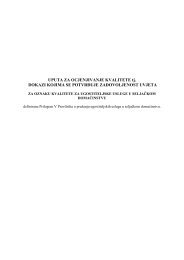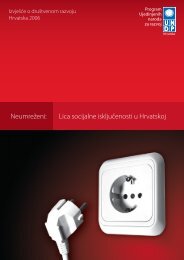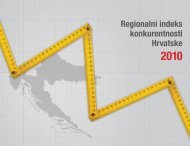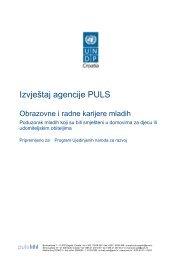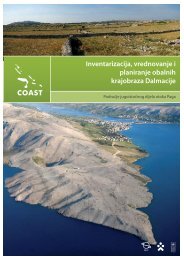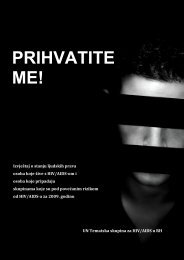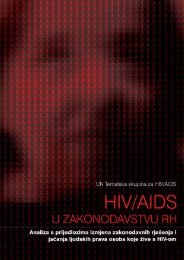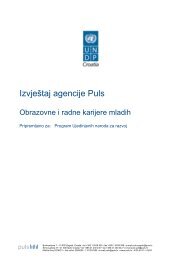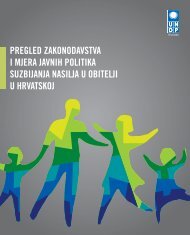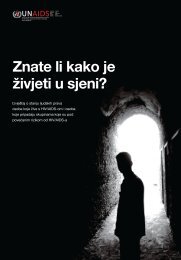WEB engleska verzija end.indd - UNDP Croatia
WEB engleska verzija end.indd - UNDP Croatia
WEB engleska verzija end.indd - UNDP Croatia
- No tags were found...
You also want an ePaper? Increase the reach of your titles
YUMPU automatically turns print PDFs into web optimized ePapers that Google loves.
THE SOCIALLY EXCLUDEDCHAPTER 3children living with HIV. This type of education isextremely important in order to try to avoid a repeatof the awkward situation in 2001 when the children’shomes for orphans refused to accept a girl left withoutparents and who spent 10 months in a hospitalwaiting for the state to find appropriate accommodationfor her. The National Programme for Preventionof HIV 2005-2010 recognizes that those employed injobs where they might come into contact with blood(such as those in medical institutions, educationalinstitutions, social welfare institutions, sports, publicsafety, etc.) should be trained in applying standardprotection measures to prevent the spread of HIV.The CAHIV staff have also been involved in the caseof two asylum seekers living with HIV, in which theassociation provided them with legal and materialsupport. Finding accommodation for older peopleliving with HIV, and those with a deteriorated physicalcondition has become a pressing issue, given the lackof hospices in <strong>Croatia</strong>.3.13.3 Access to HealthcareThe healthcare system has focused resources for thetreatment of HIV cases at the Clinic for InfectiousDiseases in Zagreb, which has accumulated enoughknowledge and expertise to provide top qualityservice comparable to that available in EU countries.Also, the Clinic staff are able to enjoy close relationswith the patients, which contributes significantly tothe patients’ adherence to treatment as well as tothe success rate of the treatment. Still, when talkingto people living with HIV, the majority of complaintsrefer to the quality of health service and to their treatmentby other healthcare workers aside from thoseat the Clinic. The majority of people neither looks fornor expects help from other public services, such associal protection, education or employment. This lackof expectation illustrates the almost complete absenceof public policies and procedures within thosesectors and in relation to the provision of normal lifeto those with HIV.The healthcare system provides wide access to medicinesand quality treatment programmes for peopleliving with HIV, but often it is basic healthcare services(e.g., dentists) that are lacking due to hesitancyon the part of practitioners to assist a patient livingwith HIV. People living with HIV receive these servicesonly after numerous interventions by relevantorganisations and committed medical staff. Althoughthere are well established healthcare quality controlsystems in <strong>Croatia</strong>, such as licensing for healthcareworkers, medical inspection, and various medical associations,they are rarely used to protect the rights ofpatients. In fact the number of registered complaintsis practically negligible. One of the reasons for this isthe fear of patients to reveal their HIV status, whichwould further complicate their situation. In recentyears, intensive additional education has been providedto medical specialists in an attempt to increasethe general accessibility of certain health services topatients living with HIV.3.13.4 Access to EducationThe best known HIV patients in <strong>Croatia</strong> are Ela andNina, whose names appeared multiple times in themedia in September 2002. In early September 2002,the education of Ela was an everyday topic in all<strong>Croatia</strong>n daily newspapers. Ela started first grade inKaštel Novi where the parents of other children immediatelyrose in revolt, not wanting Ela to share theclassroom with their children. Ela was sequesteredin the school library, alone, isolated and stigmatised.Soon she joined a class with five students whoseparents had allowed their children to share the classwith Ela. The following year, her younger half-sisterNina began school. The girls’ foster parents decided achange in environment might be better for them, andmoved the family to Kutina, where the parents’ revoltwas repeated. This time, however, social serviceswere better prepared and the epidemiological teameducated the parents and teachers on HIV, followedby Ministers who visited the school. A group of youngpeople from Bjelovar, together with their mayor,invited the family to move to their town where theysaid that they could guarantee them support. Thefamily decided to stay in Kutina.Public opinion is marked with ambivalence. Morethan 70% of participants in media surveys are of theopinion that HIV infected children should att<strong>end</strong>school together with other children and claim thatthey would allow their children to att<strong>end</strong> classes withthe children with HIV. Since the experience of Ninaand Ela, there have been nine HIV positive children registeredin <strong>Croatia</strong>, all of whom have gone through the113



